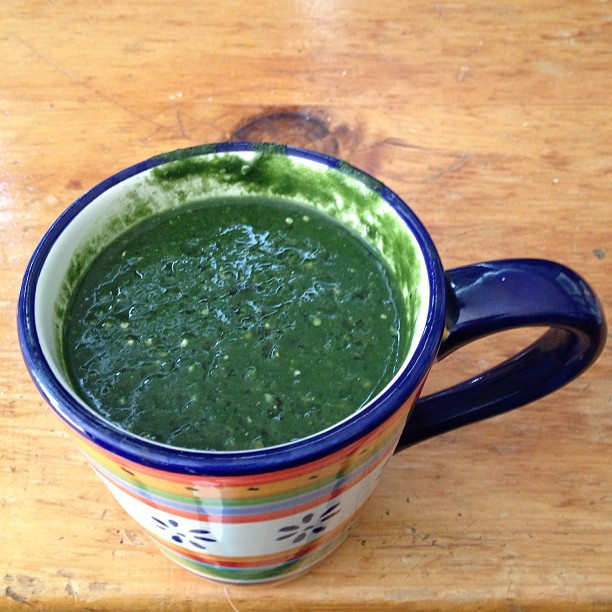I did an interview for The Setup, where creative folk go into nerdy detail about the gear they use to get stuff done.
Hey all, how have you been? Post-album it's been upgrade season around here. New gear, better health, hopefully more positive attitude. I'm getting ready to start finishing up some new music. Still not sure what to do with it yet but I'm excited (& nervous) to get back at it after such a long break. Some of these upgrades: New monitors (Event 20/20bas -> Focal CMS 65's), new bass guitar (Yamaha RBX260 -> Fender American Standard Precision), new amp (Tech 21 Power Engine -> Surf Green Fender Blues Jr), better audio interface (MOTU Ultralite mk3 -> Focusrite Scarlett 2i4), new self help strategy (CBT -> ACT), new drum skills (couldn't play drums -> can sort of play drums now), better guitar skills (could not play 7ths all over the neck -> can now play 7ths all over the neck).
I drink these smoothies now. They have bee pollen in them. And the color green.
It's been 2013 for like two days! Happy New Year, everybody. 2012 was a tough one but overall good. With the album out the door I'm excited about working on new stuff and getting better at writing and recording music. It's been really nice, I forgot how much I missed it while I was in album finishing hell. My first step was to upgrade my monitors. After a lot of research I bought a set of Focal CMS 65's and oh my god I'm happy with them. I feel like I can hear everything in the mix now. It's actually a little horrifying because there are all these recording choices I didn't realize I was making but it's exciting, it feels like I can control sound better now.
Meanwhile, I'm getting ready for our Toronto show on the 26th.
Getting the laptop into the live show has been a long dumb technical process. It's been working solid now for a long time so the last step was to get it all into a nice portable form factor that was quick and easy to set up and tear down. I think I'm just about there:
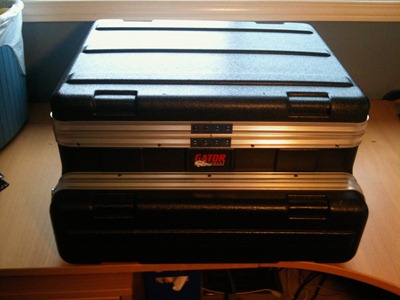
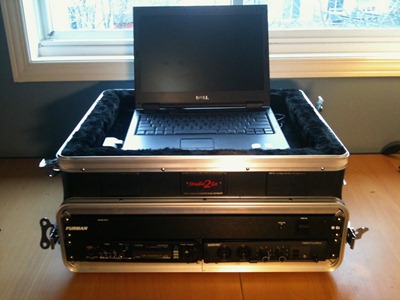
I bought this Gator Studio-2-Go case - which is a 2U rack case (front and back) as well as a laptop compartment on top (and most importantly a hole between the rack and laptop compartments for cable runs). Getting it was a stupid ordeal. I actually couldn't find it anywhere in Canada (everyone said it was discontinued) so I had to order it from Sweetwater, get it delivered in the US and drive across the border to get it. Sine then it's been a gradual process figuring out everything I need in it.
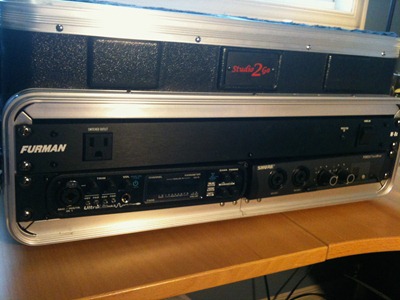
In the front (sorry for the crappy photos) I've got a Furman M-8X (rack-mounted power strip), a MOTU Ultralite mk3 (sound card) and a Shure PSM200 wireless transmitter (for feeding the click to the drummer). The power strip means I only have one power cord for the whole box, which is great.
In the back:
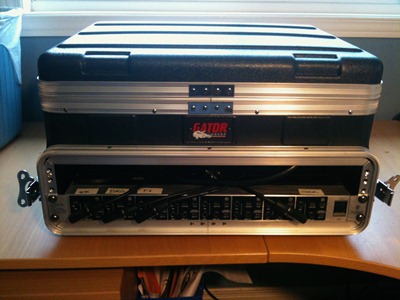
The sound card's outputs go into a Behringer ULTRA-DI PRO DI800, giving the sound dude three channels of DI'd output. I had to learn how to build some short angle patch cables since non-angled ones wouldn't fit with the back cover on.
Remaining issues:
- I need an 8-channel XLR s-s-snake for the DI outputs (this has been ordered.)
- The power supply for the PSM200 is one of those dudes with the AC adapter block separated from the plug. Meaning the block is floating around in the case, threatening to knock all my other connections out. I'm not sure how to secure it down or if I should try and replace it with a different adapter.
- The Firewire adapter in the laptop sticks out of the side of the laptop a great deal and makes the side-foam the case comes with not fit properly. I guess I'll cut a hole in it.
- I wish it was easier to get the DI in and out in case I need to adjust something. Right now I can squeeze my arms in but I'm only getting fatter so that's not a permanent option. I don't know much about racks - is there a. thing for that? A rack drawer maybe?
So instead of bringing in a pile of devices and having to set up all my cables each time, I'm down to one AC adapter and a handful of XLR outs and I don't need any DIs from the house.
That was a lot of work.
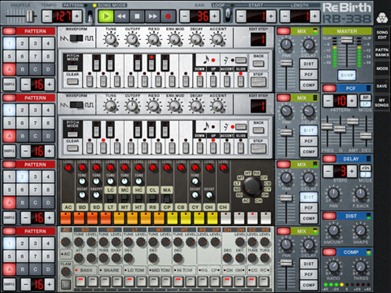 The original Rebirth RB-338 was great. Released in 1996, I remember it being one of the first software synthesizers on the PC that seemed serious and sounded cool. An iPhone version has been around for a while but the iPad version was just released for $14.99 and I couldn't resist trying it out.
The original Rebirth RB-338 was great. Released in 1996, I remember it being one of the first software synthesizers on the PC that seemed serious and sounded cool. An iPhone version has been around for a while but the iPad version was just released for $14.99 and I couldn't resist trying it out.
The multi-touch is what makes the difference of course. While the screen is a tiny bit smaller than would be optimal - it's hard to select drums without accidentally engaging a button or knob - being able to manipulate multiple controls at once without using a mouse is undeniably fun. You can actually feel like you're jamming to a certain extent.
Ultimately though I feel disappointed and am not sure it was worth the $15. We'll see if I go back to it. Without any sort of MIDI support (sending or sync or export) this is just another bleep-toy that won't really integrate with my existing audio tools.
The 303 sounds are also pretty dated sounding to me (or at least not as fat as modern soft-synths), but the drums are still thick and fun. There's also some ugly digital clipping if you start driving it too hard which is less present in modern plugins.
So, much like the original Rebirth, I'm still waiting for an iPad music app that seems serious and sounds cool.
This video got me all nostalgic and thinking about the audio devices I've had over the years:
It's hard to remember the order of all these but here's what I can piece together:
- PC Speaker on my 4/8mhz (turbo) LANPAR IBM PC - It was nearly intolerable to listen to but I still enjoyed it, I thought it was amazing and I found music like the Monkey Island theme (in the video above) and Leisure Suit Larry's theme very catchy.
- Covox Sound Master - This was only supported by a few games and was probably the first time I was burned by buying new hardware that wound up gaining no popular support.
- CMS Game Blaster - I had this instead of an Adlib card. The Game Blaster had less support than the Adlib but technically sounded better. I wouldn't say I got 'burned' but I definitely should have gotten an Adlib instead.
- Sound Blaster - The Sound Blaster was supported by nearly all games, which was great. This was the my first "painless" experience with PC audio. (Not sure if this came before or after the Gravis Ultrasound.)
- Gravis Ultrasound - I was into game development at the time and got a free one of these from Gravis's developer program which was awesome. I seem to remember upgrading the onboard RAM but I have no idea why I would do that. The Gravis had OK support but wasn't as universal as the Sound Blaster I believe. It could play MODs and S3Ms (could the Sound Blaster? I can't remember), which was fantastic.
- Sound Blaster AWE64 - I was trying to "get serious" about music production. I got a RAM upgrade for the AWE64 so it could load larger Soundfonts. I never really used Soundfonts much.
- Various onboard sound devices - Computers became powerful enough I didn't need specialized hardware for games and MOD/S3M trackers.
- Echo Darla (20 bit) - this was my first "pro" sound card, with low latency drivers and so on. It was expensive and it was such a bastard. It conflicted with nearly everything in every system I ever put it into. When it worked it was great, when it didn't I was in a world of IRQ conflicts and buffer sizes and beta ASIO drivers and random crashes and bullshit. I still have it in a box and when I look at it my eye twitches.
- M-Audio Delta 66 - This is what I'm using now on my desktop/recording machine. I should have bought the Delta 44 instead since it was $50 cheaper and I never use the Digital I/O. But it's been rock solid and I've had no problems. I think about upgrading sometimes but I can't think of any reason to.
Also additional mobile devices:
- Edirol UA-1EX - This is a little USB gizmo that works pretty good, low-latency ASIO performance to any device I've tried. I bought it thinking maybe I'd use it for live performance but it seemed a bit un-pro. Now I use it on my live synth computer plugged into a DI and it's been working well.
- M-Audio FireWire 410 - I bought this for live performance and it was way too erratic. It would click, crash and sometimes just not be recognized by the computer. I went through several different FireWire cards and eventually gave up.
- MOTU Ultralite mk3 - More FireWire awfulness initially - had to buy a FireWire card for my laptop with a Texas Instruments chipset. Then a weird German adapter to keep the card from wiggling around in the slot. Now it's been rock solid stable - as long as you keep the wifi on the laptop disabled or else it emits an intermittent high pitched sound.
Man, that list makes me frustrated just looking at it.
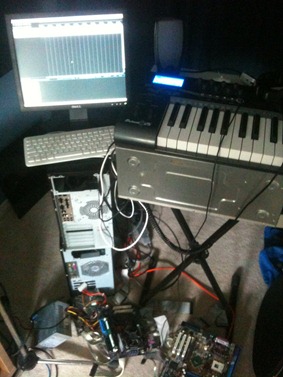 Despite some shows coming up in the next few weeks we decided to try and add some lead synth to the set at the last minute. I had been playing solos on guitar but it doesn't have the same feel.
Despite some shows coming up in the next few weeks we decided to try and add some lead synth to the set at the last minute. I had been playing solos on guitar but it doesn't have the same feel.
So the past week and a half has involved me trying to put together a stable PC running Windows XP, Reaper and various VSTis that can reliably run headless (no monitor, no keyboard, no mouse). ASIO drivers are provided by an Edirol UA-1EX as the ASIO4ALL drivers were too clicky and laggy.
The plan is then to cram all that into a 2U rackmount server case and then stuff that into a gig case for an instant on, portable, minimal worries synth machine. It would be great to get a solid state hard drive to minimize the moving parts, but my budget for this is low as balls.
As you can see from the photo on the right and my torn-up bloody hands (not pictured) it's been a struggle to find a combination of working spare parts. I thought I had solved it all a week ago but the motherboard I was using was only USB 1.0 and would intermittently flake out with the M-Audio Axiom 25 I've drafted into service.
Of course I'm currently running the show off a laptop but I felt having it do synth duties as well was too risky. At least this way if the laptop fails we can still put on an OK show. And if the synth machine fails I can still shred out some crappy guitar solos. If both fail, I will just run away from the venue as fast as I can.
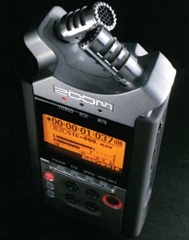 I bought a Zoom H4N field recorder a few months ago. I wanted to broaden the sounds I use in my recordings and do some experimental stuff. I don't have a huge field recording passion - I'm not very interested in recording a storm or a train. But I do like recordings of people behaving naturally. It's been fun, the quality is great and listening back to most recordings I feel like I'm in the room again. Which for a lot of situations is more interesting to me than taking a photograph as far as capturing a memory.
I bought a Zoom H4N field recorder a few months ago. I wanted to broaden the sounds I use in my recordings and do some experimental stuff. I don't have a huge field recording passion - I'm not very interested in recording a storm or a train. But I do like recordings of people behaving naturally. It's been fun, the quality is great and listening back to most recordings I feel like I'm in the room again. Which for a lot of situations is more interesting to me than taking a photograph as far as capturing a memory.
So here's a montage of some of the recordings I've done with it since I got it:
Field Recording I [5.4 MB]
- [0:00] Justin (my drummer) has a giant, giant empty room in his basement. This is me trying out the reverb in it.
- [0:05] At a Barn practice I made some jokes about Bryan Adams and then wound up singing Summer of '69.
- [0:25] And then "Run To You" but I couldn't remember any of the lyrics really.
- [0:39] Then, after being exposed to a bunch of ska recently, I suggested the worst combination in the world might be a ska version of Bryan Adams' Everything I Do, I Do It For You. [1:03] And then we improv it.
- [1:28] Total Breakdown in Brad Sucks practice. Next time I'm gonna feed the computer output (vocals and synth) into the H4N. I think that'll sound better.
- [1:55] Rehearsal of I Think You're Alright for a performance a few weeks ago.
- [2:31] As a favor I did sound for a bluegrass show by Yonder Hill. They needed eight microphones but they were very good. This is them doing "Beefsteaks When I'm Hungry, Whiskey When I'm Dry". There is a banjo solo.
- [2:54] My guitarist Ben and his wife performed an intimate Valentine's dinner-music show. This is them covering Here Comes the Sun by The Beatles. On this one I fed the monitor output into one of the H4N inputs so the vocals sound a lot clearer.
- [3:28] At Brad Sucks practice: Ben randomly plays an Irish jig riff, Justin says "dance, leprechaun, dance", and I yell "WHERE'S ME GOLD" in my evil leprechaun voice and then the delay from the microphone makes us all giggle.
It's a sweet little device. Main complaint is I wish it powered up quicker.
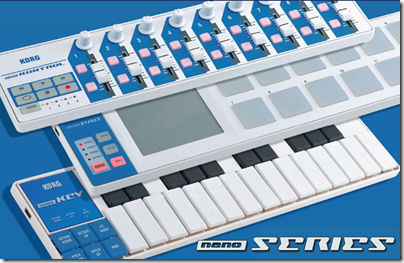 I'm not much of a keyboard player. I started writing music on the computer tapping notes into trackers with the computer keyboard. I also have a shitty right arm that wigs out when I play keyboards. So I've wound up trying a variety of different MIDI keyboards and for the most part they sit beside me and I put papers and junk on top of them and then avoid using them because I'm too lazy to clean them off. So I wind up playing basic sequences in with the computer keyboard.
Enter the inexpensive, tiny Korg Nano Series.
I'm not much of a keyboard player. I started writing music on the computer tapping notes into trackers with the computer keyboard. I also have a shitty right arm that wigs out when I play keyboards. So I've wound up trying a variety of different MIDI keyboards and for the most part they sit beside me and I put papers and junk on top of them and then avoid using them because I'm too lazy to clean them off. So I wind up playing basic sequences in with the computer keyboard.
Enter the inexpensive, tiny Korg Nano Series.
I snapped these up when I read about them, thinking they'd come in handy for live performances (I'm not optimistic enough to think I'll write music away from my office) but when I got them home I realized they solve at least part of my MIDI keyboard problem. Now I keep them on a shelf under my desk and pull them out whenever I need them.
The Kontrol and Pad are great - simple and effective and relatively sturdy. I've tried many different drum pads over the years and the nanoPad is actually my favorite, which is surprising for such an inexpensive device. The nanoKey is the most dodgy, but also the one I've used the most, so it can't be that bad. The keys feel exactly like (kind of cheap) laptop keys. It has the same weak/wobbly spring feeling. I'm not looking for sweet action, but it would be awesome if they felt slightly more crisp - something comparable to a child's plastic keyboard would be fine.
My only other complaint isn't Korg's fault (I think) - the nature of these devices is that I want to plug them in as I need them, swapping them out at will. But all the audio software I've tried with needs to restart (or at least reset the audio device) each time I plug in or unplug a device. Minor thing I know.
All in all, they're very useful tools and I'm happy to have 'em.
Update (3/4/11): My Nanopad randomly died and in researching fixes that seems to be an epidemic. So I wouldn't bother. The Akai LP line seems to be more durable and that's likely what I'll switch to.
I've been busy lately re-doing my “studio†(aka office). First thing was to get a new desk (out with the Jerker, in with the Galant). After that it was an Eina night stand and a Galant drawer unit. The most recent thing has been building my own acoustic panels to deaden the sound in here a bit for better mixing and recording:
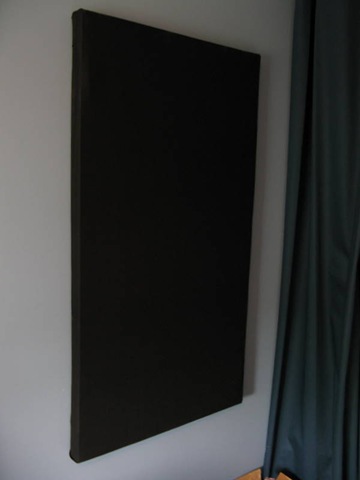
I had researched acoustic panels a bunch and there was a ton of conflicting information out there. It wasn't until I found this great how-to that it seemed approachable. The big issue for me was that the rigid fiberglass Americans use is Owens Corning 703 or 705 and figuring out what the equivalent was up here in Canada was difficult. (Turns out it's OFI 48).
After locating the right rigid fiberglass, I found some black muslin fabric and cut up some plywood I had laying around. I've made two panels so far – the second one is far uglier than the first because I am not skilled, but both of them provide a startling amount of sound dampening. I've been making non-sound nerds speak against my regular wall and then into the panels and they've been shocked at the difference even if they don't care about acoustics.
I'm going to build a few bass traps for behind my monitors and then a few free-standing panels I can move around and use for whatever and then I should be good for a while.
Yep, this is awesome:
 Reaper 3 came out a little while ago and I've mentioned that I'm experimenting with switching to it from Cubase. So far I can't imagine going back to Cubase. Some of the things I like:
Reaper 3 came out a little while ago and I've mentioned that I'm experimenting with switching to it from Cubase. So far I can't imagine going back to Cubase. Some of the things I like:
- It's fast and small. While the 4.4MB installer file size is great, it's the responsiveness and quick loading time that are truly awesome. Cubase feels bloated and slow after using Reaper, as do most DAWs.
- Powerful. The amount of features in it are ridiculous. You may have to hunt for the options, but 99% of the time it's there.
- I haven't had it crash on me yet.
- It's fully customizable. I feel like I can trick it out as much as I want. From themes to keyboard shortcuts to actions, you can make it your own.
- Frequent useful updates. Unlike Cubase's usual “launch buggy, gradually patch those bugs and save any useful new features for the next version you have to pay for†you actually get an amazing amount of updates and improvements.
- An active community and approachable developers. Reasonable or good ideas get implemented quickly, developers are responsive in the forums, lots of people were helpful when I was flailing around in “I'm used to Cubase!†land.
- It plays nice with dual monitors. HOORAY.
- Quick search of VST plugins.
- I don't feel locked in. Project files are in plain text, you can export your stuff easily. You can move your preferences around easily.
Some things I don't like so much:
- There are so many options that new (and/or less tech-savvy) users will likely feel overwhelmed hunting down the right checkboxes to get the behavior they expect. It's awesome that it's so customizable, but I'd love to see them pick some more universal up-front options and move a lot of the tweaks to a Firefox about:config style interface or just an .ini file.
- A lot of the comping/audio behavior doesn't make a lot of sense to me. The logic behind which items play and which don't when they overlay each other on the same track still confuses me, so I try and avoid it. Comping generally works but lacks the precision of Cubase or Logic.
- Unlike versions 1 and 2, Reaper 3 doesn't have my song Making Me Nervous as the default project. :( :(
Anyway, it's been good and I recommend trying it out. There's an un-crippled evaluation version so you've got nothing to lose.
After having so many live performance troubles with the M-Audio Firewire 410, I looked around for the best alternative. My research lead me to the MOTU UltraLite mk3. People referred to it as “rock solid†and I had previously heard lots of great things about MOTU hardware. There's not a lot of competition in this area for some reason. Anyway, I bought one.
Immediately I started having audio drop-outs. Firmware upgrades were involved. I filed a trouble ticket and I complained on Twitter. I read lots of posts and comments about MOTU's “legendary†bad support (which was not so legendary that I knew about it before I bought one of their products). I wound up going back tonight to have a look at my ticket's status and check this out:
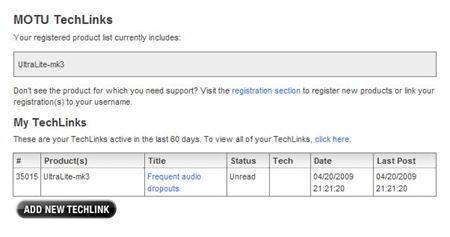
Wow, ten days later and my ticket's still Unread. I mean I guess appreciate that they're up front about not caring, but maybe putting forth at least the illusion of customer service would be a better business strategy. I don't know.
For the past year I've been thinking a lot about solo guitar interfaces. One of the challenges with being a guitarist and playing solo is that both hands are almost constantly busy with the guitar and your feet are usually busy with pedals. Doesn't leave a lot of other options.
I've thought up a lot of ways the guitar as an interface could be improved or augmented and the simplest idea seems like it would be to put a bunch of easily accessible buttons in the guitar and have those buttons simulate keystrokes on my laptop. How hard could that be? Let's see.
Step one:
I ordered some Seimitsu PS-14 arcade buttons. A lot of the buttons I found were wayyyy too deep (such as these) but these ones looked like they might not go all the way through my guitar and halfway into my torso while playing.

I also impulse bought an Arduino. The Arduino is awesome but turning button presses into keyboard strokes isn't really its main deal. So I ordered an I-PAC VE which is dedicated entirely to simulating keyboard controls.
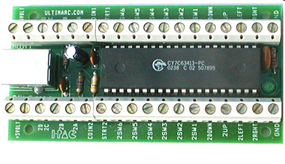
Step two:
Months later when the I-PAC finally arrived, I wired up the buttons and the board and it all worked on the first try. I made a little cardboard stand for testing:
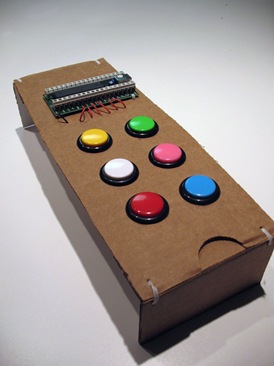
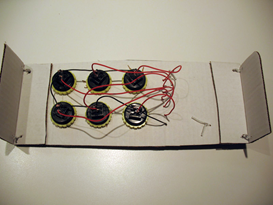
But it doesn't look like there's much testing to do, it's pretty brain dead easy. I had it entering keystrokes on the computer and triggering clips in Ableton Live within minutes. Windows XP even recognized the I-PAC without any additional drivers, very nice.
Step three:
Where should the buttons go on the guitar? I put some cut-out circles on it to see where they'd fit and be most useful:
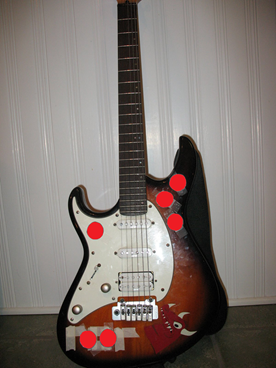
This is the layout I'm thinking of right now. There's a lot to take into consideration, such as:
- Ease of access while playing (the upper right ones seem close enough I'd be able to hit them with only a brief pause in playing)
- Staying away from locations where accidental hits are likely (the right side is where my arm is while playing)
- Making sure I don't interfere with any of the guitar's guts
- Keeping them far enough away from the edge that I don't weaken and collapse it
Right now I'm wondering if I should try to house the circuit board inside the guitar and run a USB cable from the guitar to my laptop or should I run the wires from the buttons to the external I-PAC which would be by the laptop? I do not know.
David points to this Denon AKDL1 Dedicated Link Cable on Amazon. The tags are wonderful. A small sampling:
snake oil (383)
ripoff (338)
waste of money (314)
throwing your money away (287)
unconscionable (267)
stupid (231)
immoral (204)
pure garbage (202)
cheat (191)
denon (50)
harry potter (47)
astronomically dumb (5)
tax on the stupid (5)
as effective as using dog hair (4)
fraud (4)
nonsense (4)
rofl (4)
time space (4)
wizards_made_th is (4)
a fine product indeed (3)
cable (3)
ftl (3)
how do they get through the door with ba... (3)
pt barnum (3)
shameful (3)
wtf (3)
59 inches (2)
audiofool hardware (2)
bogus (2)
corporate taxation of the uneducated (2)
cures cancer (2)
ecstacy godlike troll-killing superwmd u... (2)
eternal life (2)
ether-licious (2)
I've had a hate-on for “high-end†cables for a long time so this is wonderful to me. [via Joho]
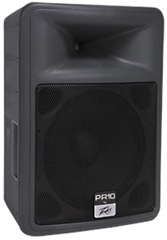 The borrowed PA in the practice garage went away so I reached into the vast (vast!) Brad Sucks war chest and bought two 270 watt Peavey PR10PN Powered Loudspeakers. Despite forgetting my mixer at home they did a nice job at rehearsal last night. Very clear and full sound, plus I have them up on stands now which I think helps them stand out from the murky low frequencies.
The borrowed PA in the practice garage went away so I reached into the vast (vast!) Brad Sucks war chest and bought two 270 watt Peavey PR10PN Powered Loudspeakers. Despite forgetting my mixer at home they did a nice job at rehearsal last night. Very clear and full sound, plus I have them up on stands now which I think helps them stand out from the murky low frequencies.
I knew nothing about monitors or live sound before. I did a lot of reading and here uh are some... knowledge:
- People on live sound forums are kind of annoying, possibly worse than recording forums. God forbid you not want to outfit your garage with multiple $1500 JBL's.
- Powered speakers are now a viable alternative to a powered mixer + passive speakers and offer more flexibility. But they're newer so they're hard to find used.
- The Peaveys have optional brackets to position them as floor-wedge monitors.
- The Peaveys actually have three inputs on each speaker. Two quarter inch and one 1/4"/XLR combo. All have level control, which is impressive.
- With powered monitors you can use a regular passive/unpowered mixer, which are cheap and plentiful.
The other point of this was to make it easier to integrate the laptop into the full band, which so far has been a huge struggle technology-wise.
Everything around here's breaking. The first channel on my Presonus Bluetube magically broke during the night. As you can see, the first channel input is pegged to the max even though there's nothing plugged into channel 1:
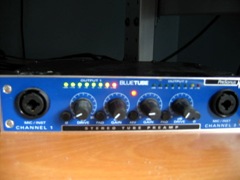
And for the past couple of months I've been aware the phantom power light on my Behringer Eurorack UB1204-PRO is always on regardless of the switch setting on the back:
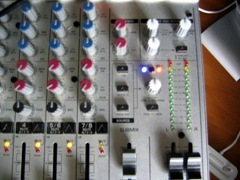
(It's the red light beside the blue one. Spooky!)
I guess I'll open up the BlueTube and see if there's anything obviously wrong inside. Wait, first I'll shake it.
Update: shaking did nothing. I opened it up and there was nothing broken looking. Poked around a bit and tugged on wires and things, powered it back on and now it works again. La-di-da.
Update 2: It broke again after a couple days of working fine. Presonus says $65 + shipping to repair. Blergh.
There's a lot of enthusiasm about Guitar Rising -- a "real guitar" version of Guitar Hero. Just to be a stick in the mud I'm calling shenanigans: machine parsing guitar playing has been the holy grail of guitar nerds for quite some time. So unless the authors of this game have figured out something that all those folks working on guitar to MIDI translators for the past twenty years have failed to do, it will probably suck ass. And if they have figured that out, why not sell a multi-hundred dollar plugin to guitarists instead?
Holy mother of Christmas I would like one of these Gibson Robot Guitars:
Also please add: unstoppable killing powers.
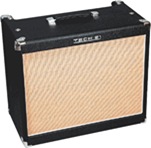 The GT-8 + Power Engine combo got a tryout in rehearsal last night. Verdict: thumbs up. It was sorta touch and go with levels and patches for a first try, so I don't think I'll be using it at tomorrow night's show, but with some tweaking I think it'll be a big improvement.
The GT-8 + Power Engine combo got a tryout in rehearsal last night. Verdict: thumbs up. It was sorta touch and go with levels and patches for a first try, so I don't think I'll be using it at tomorrow night's show, but with some tweaking I think it'll be a big improvement.
The 60 watt Power Engine puts out more than enough juice to keep up. At only half gain it's as loud or maybe louder than I ever got my Delta Blues 210 up to (my loudness demands are not very high).
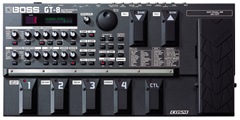 The biggest difference is the amount of tone control available. It's wonderful and horrifying at the same time -- so many choices! Also there's a fair amount of difference between what the tones sound like at whatever level I can manage in my house and band levels. That'll take some adjustment -- as well as probably me sitting in the garage diddling with settings and being eaten by mosquitos.
The biggest difference is the amount of tone control available. It's wonderful and horrifying at the same time -- so many choices! Also there's a fair amount of difference between what the tones sound like at whatever level I can manage in my house and band levels. That'll take some adjustment -- as well as probably me sitting in the garage diddling with settings and being eaten by mosquitos.
